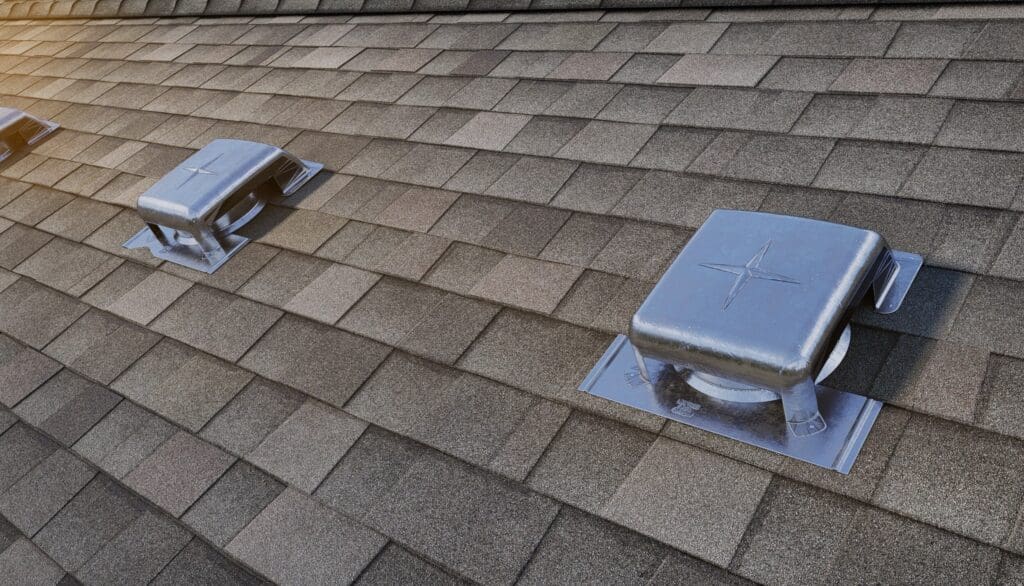The Importance of Proper Ventilation in Your Attic and Why It Matters for Your Roof
Are you aware that your roof’s health depends on proper attic ventilation? Yes, it does! Ventilation is one of the most crucial aspects of maintaining your home. When we think about making our homes energy-efficient, we often overlook this aspect. But did you know that without proper attic ventilation, the life span of your roof can be reduced significantly? In this blog post, we will explore what proper ventilation is, why it matters for your roof and how to improve attic ventilation in your home. So sit back and read through as we unravel the importance of proper roof ventilation!

What is Proper Ventilation?
Proper ventilation in your attic refers to the process of allowing air to flow freely through your attic space. This means there should be a balance between intake vents, which allow fresh air into the attic, and exhaust vents, which move hot, moist air out of the attic.
Having proper ventilation also means that you have adequate insulation installed along with it. Insulation alone cannot guarantee optimal temperatures within your home because without proper airflow within the attic space, moisture can build up and lead to mold growth or damage to wooden components.
Good ventilation helps maintain a comfortable indoor temperature and reduces energy costs by keeping heat from building up in your home during summer months. It also prevents ice damming on roofs during colder seasons by ensuring warm air does not enter the roof deck causing excess snow buildup that could weigh down on the roof structure.
Next section: The Importance of Proper Ventilation
The Importance of Proper Ventilation
Proper ventilation is crucial for keeping your attic and roof in good condition. It ensures that there is a steady flow of air throughout the space, which helps regulate temperature and humidity levels. Without proper ventilation, your attic can become a breeding ground for mold and mildew, as well as an ideal environment for pests like rodents and insects.
In addition to preventing these problems, proper ventilation also plays a critical role in extending the life of your roofing materials. When hot air is allowed to build up in your attic space, it can cause shingles to warp or crack over time. This damage may not be immediately visible from the outside but could lead to leaks and structural issues down the line.
By ensuring that your attic has adequate ventilation through vents or fans installed at strategic points on both sides of the roofline, you’ll help keep moisture levels under control while promoting better energy efficiency by reducing heat buildup during warm months.
What Happens if You Don’t Have Proper Ventilation?
Without proper ventilation in your attic, a host of problems can arise. For one, heat and moisture can become trapped in your attic space, which can lead to the growth of mold and mildew. This not only damages your roof but also poses health risks for you and your family.
Additionally, without proper ventilation, condensation can form on the underside of your roof deck during cold weather. Over time, this can cause rotting or warping of the wood structure supporting your roof.
In addition to these issues, poor ventilation can also impact energy efficiency and increase utility bills as warm air is trapped inside during summer months. It may even reduce the lifespan of roofing materials as they are exposed to excessive heat over extended periods.
It’s clear that proper ventilation is essential for protecting both your home’s structural integrity and inhabitants’ health while reducing energy costs.
How to Improve Ventilation in Your Attic
Proper ventilation in your attic is crucial for maintaining a healthy and functional roof. If you notice that your attic is stuffy, humid, or has a musty odor, it may be time to improve its ventilation.
Firstly, check the vents in your attic to ensure they are not blocked by debris or insulation. The easiest way to enhance ventilation is by installing additional vents on the roof or gables of your home. This will increase airflow and decrease humidity levels.
Another effective method for improving ventilation is installing soffit vents along the eaves of your roof. These vents allow fresh air from outside into the attic while pushing out hot air through the existing exhaust vents.
Moreover, consider adding an attic fan to help circulate air more efficiently throughout the space. An added bonus of this option is that it can also reduce energy costs during summer months when AC usage may be high.
Taking steps to improve ventilation in your attic can greatly benefit both your roof’s health and overall home comfort level.
Conclusion
Proper ventilation in your attic is crucial for the health of your roof and the overall well-being of your home. Without it, you may experience problems such as mold growth, wood rot, and even structural damage. By ensuring that your attic has adequate ventilation, you can help prevent these issues from occurring.
Remember that improving ventilation in your attic doesn’t have to be a difficult or expensive task. Simple solutions such as installing vents or adding insulation can make a big difference in maintaining the health of your roof.
Investing time and effort into proper attic ventilation will pay off in the long run by helping to extend the lifespan of your roof while also keeping energy costs down. So take action today and contact Fast Roofing to ensure that your home is properly ventilated!
